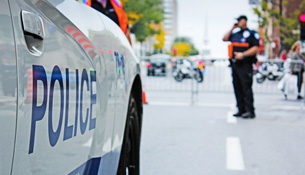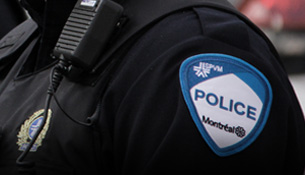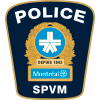
Demonstration
The SPVM respects the fundamental right of people to demonstrate, a right that must respect the laws and regulations in effect.
Cooperation from all participants in a demonstration is necessary to ensure the safety of everyone and that the expression of democracy is done in a peaceful manner.
To ensure its role as guardian of the public peace, the SPVM cannot tolerate acts of violence, criminal acts or offences that may be committed and it is obligated to intervene to reprimand these individuals.
FAQs
How much time do Police Officers give to demonstrators to leave the area when a notice to disperse has been given and how do they advise of this?
Based on the situation, the SPVM may give one or several verbal notices using an acoustics device to ask everyone in the area to leave.
The information is also generally communicated through our Twitter account (@SPVM).
If public order is endangered, public safety is compromised and demonstrators do not respond to the verbal notice given, the SPVM will escalate to a higher level of intervention to ensure that the instructions to leave the area are respected.
When is a demonstration declared to be illegal?
When offences are committed or when there are acts of violence, the demonstration is declared illegal and the SPVM will intervene to end it. Similarly, if the demonstrators occupy an area and the people responsible for this area ask for help from the Police to remove them from an area or building, the demonstration is considered to be illegal at that point.
Why does the SPVM bring SWAT teams for demonstrations?
Once the demonstration is declared to be illegal, SWAT police officers are called in for reinforcement and they must take the necessary measures to end the demonstration.
Why do the Police intervene on the street?
When the safety of participants is in danger or when offences, acts of violence, vandalism, mischief or other acts have been committed, police officers must intervene and quickly end the demonstration. The demonstration is illegal at that point.
How can a police officer be identified?
The code of ethics of Québec police officers stipulates that a police officer must not "fail to carry prescribed identification in his direct relations with the public» (Article. 5, subparagraph 3).
This means any identification (example: identification badge, identification number or identification card).
What is the role of mediators during demonstrations?
The SPVM mediation team's mandate is to prevent and contribute to reducing tensions and the risk of confrontation at demonstrations or organized gatherings in the Montréal Island area. Consequently, the police officers on the mediation team are present at many demonstrations to talk with people and answer their questions.
Mediators can be recognized by their jacket which has "Police : Équipe de médiation".
Organizing a demonstration
Do you want to organize a demonstration? You will need to follow certain instructions to make sure that the demonstration takes place in the best possible context, in a safe manner and complies with municipal regulations.
The following are guidelines to respect:
- Contact the local Police Department to provide the date, location, route of the demonstration, as well as an estimate of the number of demonstrators. If possible, 2 weeks prior to the event.
- Provide the contact information for the person in charge (name and phone number of the person in charge who must be easily reached).
- Make sure that there is no obstruction to the route due to work or other hindrance. In this respect, some roadways are subject to an assessment by the crowd control team.
- When demonstrators are marching, no one-way street can be used in the opposite direction. Avoiding rush hour is also strongly recommended. Also, you are advised to have a team of identified volunteers to assist the demonstrators.
If you have any questions or are unsure, please contact the crowd control team at your local Police Department.
Some statistics
Nearly 780 public demonstrations are organized each year in Montréal.
In 2012, there was an exceptional number of demonstrations held in the Montréal area for a total of 1377 crowd controls. Of this number, 700 demonstrations were related to the social movement protesting increased tuition fees. Moreover, no large Canadian or even American city had as many daily demonstrations, with such intensity, in such a short period of time.
Some rules to follow to ensure a smoothly run demonstration
- Respect the laws and regulations in effect
- Follow the instructions given by police officers, to ensure your safety
- Demonstrations that occupy buildings or areas, either public or private, will be evicted if the owner asks the police to do so
- Leave the area peacefully when a notice to disperse is given
- If you did not hear the verbal notice given and you see a SWAT team approach (police officers with shields), this means that police are prepared to intervene and you need to leave the area



